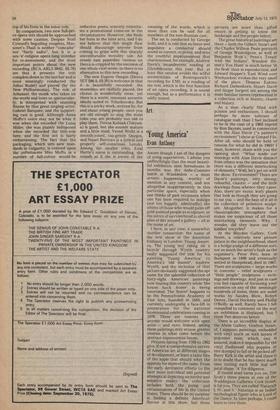The
Spectator. July 12, 1975
pictures are more than gifted essays in getting to know the landscape and the people better.
The great historical paintings are there — both the Gilbert Stuart and the Charles Willson Peale portraits of George Washington, as well as Benjamin West's 'Penn's Treaty with the Indians'. Winslow Homer's 'Fox Hunt' is much better 'in the flesh' than in reproduction, and Edward Hopper's 'East Wind over Weehawken' evokes the very smell of the place. Thomas Eakins, Richard Diebenkorn, Stuart Davis and Singer Sargent are among the more familiar names represented in a collection rich in beauty, charm and history.
As a man clearly filled with passion and enthusiasm, 1 should perhaps be more tolerant of catalogue tosh than I feel inclined to be in the case of a 1965 reprint by Ken Baynes, used in connection with the Alan Davie ("a painter's environment") show at Gimpel Fils. After all, who should be held to ransom for what he did in 1965? I must, however, share with you the opening shot: "What made our meetings with Alan Davie distinct from others was the sensation that there was a different interlocking of elements." Well, let's get on with the show. Environment? There are Davies paintings, very strong, colourful, chaotic — and the little drawings from whence they came. Also, there are exotic leafy plants that look as though they are going to eat you — and the best of it all is his collection of primitive sculpture. Altogether, it makes for a claustrophobic atmosphere that makes me suspicious of all those interlocking elements. Why, I wonder, did they leave out the kiddies' tricycles?
At the Blayden Gallery, Cork Street, a relatively new picture palace in the neighbourhood, there is a hodge-pqdge of a different sort, not so much the artist's fault as the organiser's. Peter Pen, born in Budapest in 1899 and eventually settled in Hampstead, died in 1967There are sculptures — large works in concrete — relief sculptures — "little people" sculptures — etchings and drawings. And just in case you feel capable of focussing your attention on any of the seemingly hundreds of items, there are some works by Sandra Blow, Robyn Denny, David Hockney and Phillip O'Reilly as well. Rarely have I felt compelled to comment on the way an exhibition is displayed, but I think Pen i deserves better.
There is an incredible display at the Alwin Gallery, Grafton Street, of, I suppose, paintings, embedded with vinyl stuck on with layers of polyester resin, which, one is assured, makes it impossible for the vinyl (fashioned into poppies or tree stumps) to fall or be picked off. BarryKirk is the artist and there is little doubt that he has spent much time cutting each little leaf and petal shape. 'A' for diligence.
If rusted steel turns you on, Tim Scott's three pieces at one of the Waddington Galleries, Cork Street, is for you. They are called `Nataraja I, IV, and V.' Nataraja is an Indian mythological figure who is Lord of the Dance. In time perhaps, I could learn to love them.


































 Previous page
Previous page